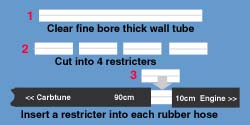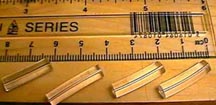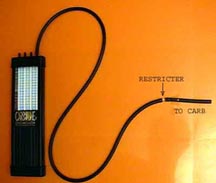I have both a Motion Pro Toxic Tune™ mercury tuner and a Morgan Carb tune. I put restricters in the hoses of both tuners exactly per instructions and in
my case it correctly damped both the tuners. The Toxic Tune barely has a visible flutter and the Morgan has just the minimum flutter to keep it working correctly, barely 1-2 small divisions so it is fairly easy to visually average the reading. It is critical that the restricters are made and installed exactly as detailed in the instructions. Morgan does say that there are unit to unit variations which may need compensation beyond the restricters.
If a metal slide tuner like the Morgan still has too much flutter one possibility is to lengthen the hoses, and most importantly, keep the hose extension lengths EXACTLY the same. Morgan also suggests that tilting the tuner will help damp the fluctuations.
As previously mentioned, if you have a fluid based tuner do not whack the throttle open and then chop it closed. The resulting vacuum spike will cause all the fluid/mercury to be sucked into the engine. As a bonus with the Toxic Tune you then get to breath the mercury as fumes. For best effect stand directly in front of the exhaust pipe and breath deep. Research the term "Mad as a hatter".
Actual mercury or slide height will vary with barometric pressure and altitude so don't get hung up on the absolute value reading, what is important is the balance between the readings. Cylinder to cylinder balance is what a throttle body sync is all about.
RTFM? I'm a real man and would never debase myself like that. :lol: None the less, in part this is what Morgan says:
[Morgan]
Damping. The restricters must always be used.
Without restricters the rods will fluctuate wildly. There are two components to the damping.
1. The small amount of friction between the rods and guides which is overcome as soon as the pulsating vacuum of the engine is connected. This friction can vary from tube to tube in the Carbtune and is not a fault.
2. The air-flow restricters that fit inside the rubber tubes and damp the fluctuations. There will always be a small amount of fluctuation and this is necessary for the gauges to work properly. Do not oil the rods.
How to make the dampers
Refer to drawing opposite. In the bag with the adapters you will have received a fine bore thick wall clear plastic tube (No 1). It is about 8cm long x 5mm diameter. With a craft knife cut the thick wall tube into four roughly equal pieces. These are the four restricters (No 2). (For the 2-column the tube is about 4cm long and is cut into 2 pieces.)
Cut about 10cm (4") off the end of each 1 metre black rubber hose. Push a restricter into the 10cm rubber hose. Now push the remaining 90cm (3ft) rubber hose onto the other side of the restricter (No 3). Do this for each hose.
The length of the rubber hose is not critical. You can make them longer by adding more hose. The restricters need to be about 90cm from the Carbtune. The longer the tube between the restricters and the Carbtune, the more the damping. The shorter, the less the damping.
The restricted part of rubber tube must go towards the engine, not the Carbtune. If the restricters are beside the Carbtune it will not be properly damped. The restricters will reduce fluctuations to acceptable levels for most bikes but some bikes may still give readings that pulsate too much even with the dampers in place. Moving the gauges very slightly off vertical will add some extra friction and damping but make sure the rods are still pulsating slightly or the readings may be affected.
The rods need to pulsate to some degree for the gauge to work properly.
[/Morgan]



































































